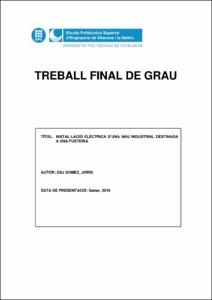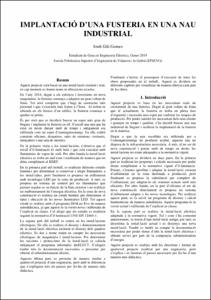Mostra el registre d'ítem simple
Instal·lació elèctrica d'una nau industrial destinada a una fusteria
| dc.contributor | Caumons Sangrà, Ramon |
| dc.contributor.author | Gili Gómez, Jordi |
| dc.contributor.other | Universitat Politècnica de Catalunya. Departament d'Enginyeria Elèctrica |
| dc.date.accessioned | 2019-03-28T07:59:40Z |
| dc.date.available | 2019-03-28T07:59:40Z |
| dc.date.issued | 2019-01 |
| dc.identifier.uri | http://hdl.handle.net/2117/130964 |
| dc.description.abstract | [CATALÀ] Aquest projecte està basat en una instal·lació existent i real, en cap moment es donaran noms ni ubicacions exactes. En l’any 2014, degut als esforços i inversions en nova maquinària, la fusteria comença a adquirir un gran volum de feina. Tot això comporta que s’hagi de contractar més personal i que s’executin més feines a l’hora. Al trobar-se ubicada en els baixos d’un edifici, la fusteria comença a quedar-se petita. És per això que es decideix buscar un espai més gran de lloguer i implantar la fusteria en ell. S’escull una nau que ha estat en desús durant molt de temps i antigament era utilitzada com un espai d’emmagatzematge. En ella caldrà construir oficines, despatxos, sales de reunions, vestuaris, menjadors i una sala de mostres. En la primera visita a les instal·lacions, s’observa que el nivell d’il·luminació és molt baix i que està executat amb lluminàries de vapor de sodi. Per altre banda, la instal·lació elèctrica es troba en mal estat i realitzada de manera que no dona compliment al REBT. En la primera part del treball, es realitzen diferents estudis lumínics per determinar si conservar i afegir lluminàries a les instal·lades, però finalment es proposa un enllumenat amb tecnologia LED per la zona de producció. A més, es proposa un sistema de control per les lluminàries que permet regular-se en funció de la llum exterior i no realitzar un malbaratament de l’energia elèctrica. En la zona de nova construcció es realitza un estudi lumínic per determinar el tipus i ubicació de les noves lluminàries LED. Tot aquest estudi es realitza amb el programa DIALux Evo de manera autodidàctica, ja que aquest és la versió nova i millorada de l’explicat en classe. Cal afegir, que els estudis es realitzen seguint la normativa d’il·luminació UNE-EN 12464-1. La segona part del treball es centra en les instal·lacions elèctriques. En ella es realitza el disseny i dimensionament de la instal·lació elèctrica incloent el disseny dels quadres elèctrics. Es dur a terme tenint en compte les necessitats elèctriques de maquinària i instal·lacions. Per determinar les seccions i proteccions de la instal·lació es calcula mitjançant el programa informàtic dmELECT. S’afegeix també tota la documentació necessària a presentar per obtenir el subministrament elèctric. La segona part es presenta de manera similar a qualsevol projecte d’una enginyeria, però amb la diferencia que s’expliquen tots els passos per fer-ho de manera més didàctica. |
| dc.description.abstract | [ANGLÈS] This project is based on an existing and real installation, no names or exact locations will be given at any time. In 2014, due to the efforts and investments in a new machinery, the carpentry begins to acquire a great volume of work. All this means, that more people have to be hired and more work has to be done at the same time. As the business is located on the ground floor of a building, the space starts to get small. For this reason, it is decided to rent a bigger space where to implement the business. It is chosen an industrial building that has been in disuse for a long time. Some time ago, it was used as a storage. In order to adapt it, offices, offices, meeting rooms, changing rooms, dining room and a showroom will have to be built. In the first visit to the facilities, it is observed that the level of illumination is very low and that it is executed with sodium vapour luminaires. On the other hand, the electrical installation is in very poor condition and does not comply with the RBT. In the first part of the work, different lighting studies are done to determine whether to conserve and add luminaires to the installations but finally, a lighting with LED technology is proposed for the production area. In addition, a control system is proposed for the luminaires that allows them to be adjusted according to the external light and not to misuse electrical energy. In the new construction area, a lighting study is done to determine the type and location of the new LED luminaires. All this study is done with the DIALux Evo program in a self-taught way, as it is the new and improved version of the program explained in class. It should be added that the studies are carried out in accordance with lighting regulations UNE-EN 12464-1. The focus of the second part of the study is on the electrical installations. In this part the design and dimensioning of the electrical installation is carried out, including the design of the electrical panels. It is carried out taking into account the electrical needs of machinery and installations. The calculation to determine the sections and protections of the installation, was done with dmELECT software. It is added all the necessary documentation to submitted in order to obtain the power supply. The second part is presented in a similar way to any engineering project, but with the difference that all the steps are explained in a more didactic way. |
| dc.language.iso | cat |
| dc.publisher | Universitat Politècnica de Catalunya |
| dc.rights | Attribution-NonCommercial-NoDerivs 3.0 Spain |
| dc.rights.uri | http://creativecommons.org/licenses/by-nc-nd/3.0/es/ |
| dc.subject | Àrees temàtiques de la UPC::Enginyeria elèctrica::Distribució d’energia elèctrica::Instal·lacions elèctriques |
| dc.subject.lcsh | Electric wiring |
| dc.subject.other | Electricitat |
| dc.subject.other | Luminotècnia |
| dc.subject.other | Eficiència |
| dc.subject.other | Utilitzable |
| dc.subject.other | Millores |
| dc.subject.other | Autodidacta |
| dc.subject.other | Real |
| dc.subject.other | Implantació |
| dc.subject.other | Electricity |
| dc.subject.other | Lighting technology |
| dc.subject.other | Efficiency |
| dc.subject.other | Usable |
| dc.subject.other | Improvements |
| dc.subject.other | Autodidact |
| dc.subject.other | Real |
| dc.subject.other | Implantation |
| dc.title | Instal·lació elèctrica d'una nau industrial destinada a una fusteria |
| dc.type | Bachelor thesis |
| dc.subject.lemac | Instal·lacions elèctriques -- Edificis industrials |
| dc.subject.lemac | Edificis -- Instal.lacions |
| dc.rights.access | Open Access |
| dc.audience.educationlevel | Grau |
| dc.audience.mediator | Escola Politècnica Superior d'Enginyeria de Vilanova i la Geltrú |
| dc.audience.degree | GRAU EN ENGINYERIA ELÈCTRICA (Pla 2009) |



